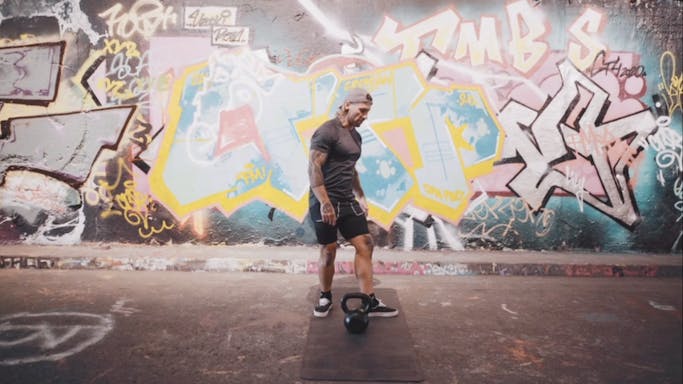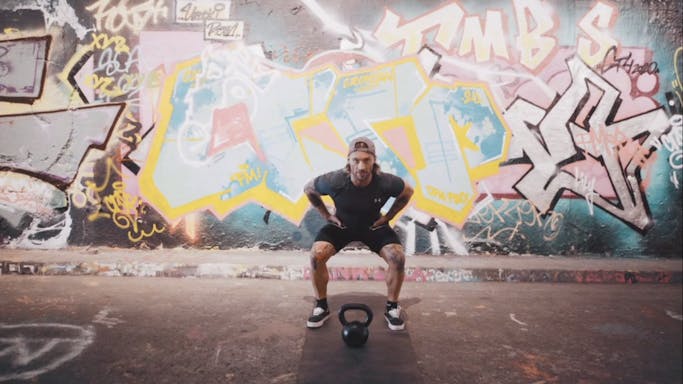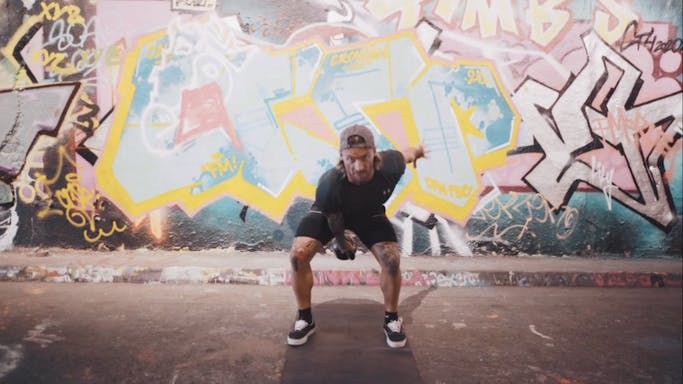Kettlebell Single Arm Swing
by Sam Franklin
How to Master The One-Handed Kettlebell Swing: A Big Hitting Classic
The kettlebell swing is one of the world’s effective and iconic kettlebell exercises—and by adding the one-handed variation to your kettlebell routine, you’ll reap even more strength and fitness-enhancing rewards.
The one-handed kettlebell swing offers a dynamic full-body workout in one swift movement, but getting it right is essential if you want to reap any real benefits and avoid injury.
Here’s everything you need to know to get started with the one-handed kettlebell swing.
How to do a kettlebell single arm swing: video tutorial
Before we dive into the benefits of kettlebell single arm swing, watch our quick tutorial video by Luke Baden, Kettlebell Master Trainer.
Luke will take you step by step through the entire movement, ensuring your form is correct and you get the absolute maximum out of the exercise.
Step by Step Guide to the Kettlebell Single Arm Swing
Step 1: The Kettlebell Single Arm Swing
To start, approach the bell, tip toes on bell. Turn one foot 90 degrees then back to straight. Repeat with the other foot.

Step 2: The Kettlebell Single Arm Swing
Little fingers chop and drop the hips to find the hip hinge position.

Step 3: The Kettlebell Single Arm Swing
Put your hand on the kettlebell, the free arm comes forward. Pack your shoulders so your armpit is flat to the body.

Step 4: The Kettlebell Single Arm Swing
Hike pass, hips drive forward and then drive up and stand tall. The free arm follows the working arm throughout the movement.

Step 5: The Kettlebell Single Arm Swing
At the top position, the kettlebell floats to this position and is weightless. Swing the kettlebell back down, hike pass and drive back up, remembering that the free arm follows the movement. When you have finished your reps, park the bell.

The body-boosting benefits of one-handed kettlebell swings
The one-handed kettlebell swing’s big sweeping movement commands power and control, offering a range of body-boosing benefits. Here is why you should add it to your regular kettlebell workout:
- Cardio fitness: One-handed kettlebell swings demand consistent and continual full-body movement, getting the heart rate up and providing a fitness-boosting, fat-burning cardio workout in the process.
- Full-body conditioning: As the one-handed kettlebell swing engages most of the body’s major muscle areas and activates the core (it requires even more control than the two-handed version), it serves as an excellent all-round joint and muscle conditioner. Excellent for everyday health and wellbeing as well as enhanced performance in a variety of sporting activities.
- Strength training: As one-handed kettlebell swings activate into the core, hamstrings, quads, glutes, back, deltoids, and arm muscles, they boast a wealth of whole body core and muscle-training benefits—essential to any solid kettlebell workout regime.
- Posture & balance: The one-handed swing is not only excellent for improving posture but by performing this dynamic movement regularly, you will also stabilise your core while improving your unilateral coordination which, in turn, will benefit your everyday wellbeing.
- Grip strength: As the one-handed swing is more demanding than its classic two-handed counterpart, it is great for improving forearm and grip strength.
What muscle groups do one-handed kettlebell swings work?
By now, you’re no doubt aware that the one-handed kettlebell swing provides an incredible full-body workout, covering the legs, core, back, shoulders, and to some extent, the forearms arms. As a guide, here are the major muscle groups worked by the one-handed kettlebell swing:
- Gluteus
- Hamstrings
- Quadriceps
- Abdominals
- Obliques
- Rhomboids
- Trapezius'
- Deltoids
One-handed kettlebell swing form tips
What to do
Now that you understand the body-boosting perks of the one-handed kettlebell swing, here are some essential tips to help improve your form and prevent any unnecessary wear and tear to your body:
- Head position: Make sure you look straight in front of you to keep your head up and avoid hunching your back. Keep your eyes focused and your back straight from start to finish and you will ensure your movements are fluid, offering maximum body-boosting value.
- Foot position: Make sure that start with your feet a little over shoulder-width apart and your toes pointing forward. Get comfortable and keep your knees flexed. When you’re ready, squat down with a straight back grip the kettlebell with your preferred hand.
- Swing placement: Once you’ve got the kettlebell in your grip, flex and bend your knees slightly, lowering the kettlebell between your legs, popping your hips forward in the process. When you’re ready, pull the kettlebell back between your legs slightly, right in the centre, to gain momentum before swinging the kettlebell up until its parallel with the floor with your arm extended. Put your free arm out like a wing for balance.
- Downward movement: Keeping your hips steady and maintaining good posture, allow your swing’s momentum to take yourself back down to starting position in a controlled fluid movement. Repeat and alternate hands at your leisure.
What to avoid
When you’re talking one-handed kettlebell swings, understanding what to avoid will help you stay clear of injury. For your reference:
- Don’t allow the kettlebell to move from side to side during your swing. Doing so will make your movements less impactful while increasing your chances of a back injury.
- Don’t flick the kettlebell with your wrist at the end of the swing—keep it straight and controlled at all times.
- Don’t leap straight into the one-handed swing straight away. If you’re fairly new to kettlebells or lack experience, focus on your two-handed swing first before progressing to the single-handed variation.
Related kettlebell swing exercises
If you want to complement your one-handed kettlebell swing workout, here are some related exercises you should try:
Kettlebell Single Arm Swing video transcript
This is the video tutorial for the Kettlebell Single Arm Swing
This is exactly the same as a 2-hand swing except we’re removing one hand from the bell.
This creates more of a balance challenge, more of a grip challenge and also more of an abs challenge as we work to resist rotation, which is one of the functions of the core itself.
So, setup is the same.
Approaching bell. Tiptoes on bell. One foot out for 90 degrees, back to straight. Same thing other side.
Little fingers chop and drop into the hip hinge position.
One hand on bell, free arm comes forward.
Pack the shoulder still, so flattening the armpit to the body.
Hike pass then drive up stand tall.
The kettlebell is weightless at the top position. Free arm follows the working arm throughout the movement.
Then park the bell.
So, really important: When you’re in this position, free arm is forward.
We hike pass, hips drive forward, kettlebell floats into this shape.
From there, way back down and drive up. Remember, that free arm must follow the working arm.
That was the tutorial video for the Kettlebell Single Arm Swing.
